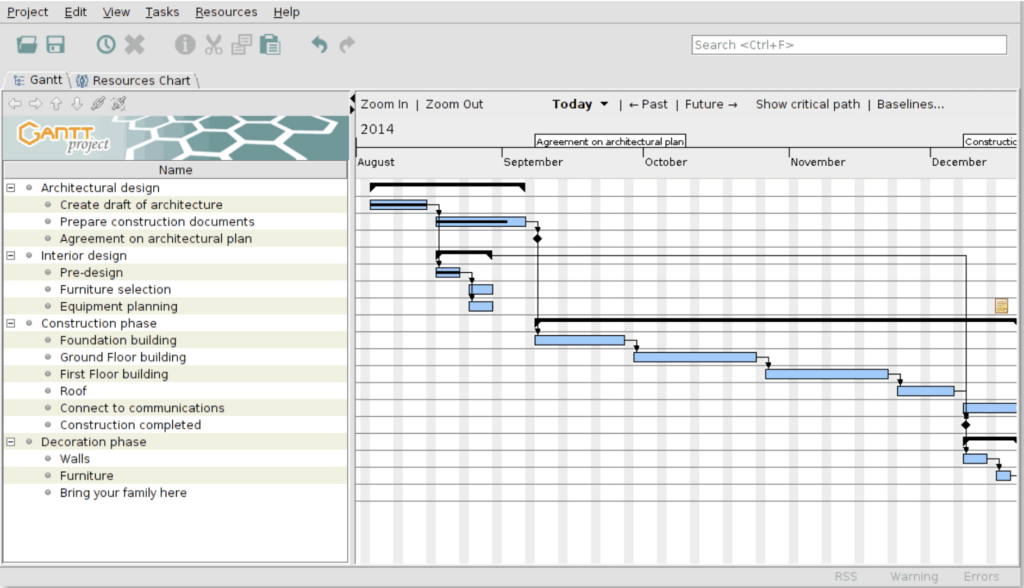
If you are planning a media project – whether it be a new programme, covering a live event, launching a new product, there are certain rules you should observe.
In the first in this series of three articles we looked at the basics of project development for a media organisation in order to launch new products or refresh current output.
That module included defining the target audience, setting out the unique editorial proposition, assessing the cost of the project, and calculating the return.
In other words, you have done the thinking. But there is a lot more thinking still to be done, if you are to turn your idea into a real-life product. To do that, you need to use the skills and techniques of project management.
Many books have been written on this subject. There are detailed project management methodologies you could learn, if you wanted to do so. A man called Gantt invented a useful chart that helps you manage your project.
But you can do without all that if you follow the basic rules. Here they are:
Specification, time, and money
The three main components of any project are the specification, the time allowed and the money available. You want to finish the project to specification, on time and within budget
This speaks for itself, but it is vital that you understand the three components in detail before you begin work. Then you know, and everybody else knows, precisely what you are trying to achieve. Your whole project plan is based on that understanding.
The reason I make this point is that external forces often want to change the basic components after the project has started. They might (and often do) try to change the specification, bring forward the launch date or reduce the amount of money available.
They have to understand that any change in the specification, the time or the budget might mean a total re-think.
Planning
It is important that you plan everything before you do anything. If you forget all the other rules, do not forget this one. Your thinking time is your most valuable time. Get a complete picture of the project in your head before you allow work to start
Workstreams
Next you need to identify the workstreams involved in the proposed project. The workstreams are the pieces of work that all need to be done.
They might include recruitment, training, buying equipment and software, commissioning design work, writing technical specifications, producing guidelines or standards, renting space, getting permissions, booking travel, market research, rehearsing, printing, marketing, producing pilots or prototypes, testing – whatever. You need a complete list.
The project plan document
Once the workstreams are in place you need to write down all the elements in a project plan document.
This can be a large piece of paper, a Gantt chart, a spreadsheet or a whiteboard in your office. Start by writing today’s date at the top of the left hand side, and the date you want to launch your product at the top of the right hand side (If you read right to left, invert these instructions).
Let’s say there are two months between today’s date and the launch of your product. Divide the space between them into equal time segments. For example, you might have two months to complete the project, so your top line will be divided into eight segments representing eight weeks:
| Today’s date | L-7 | L-6 | L-5 | L-4 | L-3 | L-2 | L-1 | Launch date |
Below “Today’s date” you are going make a vertical list of all the workstreams – the things that need to be done.
In the row next to each workstream heading, you are going to write the critical milestones, in the week when they must be achieved.
Let’s say one of the work streams is Design. It might appear like this, showing the important milestones:
| Today’s date | L-7 | L-6 | L-5 | L-4 | L-3 | L-2 | L-1 | Launch date |
| Design | Write design brief | Invite tenders | Choose supplier | Review designs | Make final choice | Design work delivered |
Do this with all the workstreams. In particular you are looking for dependencies: where one piece of necessary work can’t be carried out until another has been completed. Here is an example of a Gantt chart showing dependencies in an architectural project:

Plan for the unexpected
It’s important with any project to include a bit of slack to allow for the things that will inevitably go wrong.
Planning is the central to success, but as Mike Tyson said: “Everybody has a plan till they get punched in the mouth”. Things WILL go wrong. So you have to build a little slack into your project to allow for that: a bit more time than you think you’ll actually need; a bit of money tucked away in case an emergency arises that can be solved by throwing money at it; and one or more of the specifications that can wait until after launch, without drastically affecting the outcome, if need be.
Teamwork and collaboration
Ensure that you share the plan with your team, and let them improve it if they can.
The team will actually do all the work and they need to own the results. You achieve that by listening to them, involving them and respecting them. Make sure they are all absolutely clear and supportive of the objective. If people are doubtful about the wisdom of the project it would be better for them to find somewhere else to work.
Get started
Now the work can actually begin. And you will soon notice the benefit of having thought everything through carefully beforehand.
Communication
Make sure you communicate with your team constantly and meet together at least weekly.
Set an example to the team by understanding what they are doing. If you are not interested in their work, they won’t be either. Know all the details of the project inside out. Be available to everyone and don’t ask anyone to do something you would not be willing to do yourself.
Chase progress sensitively
You need to ensure people are doing what they are expected to do, so a project manager must always chase progress, but it is important not to overwork people – that is not sustainable.
It is your job to make sure that deadlines are met and the weekly meeting is a vital checkpoint. Know exactly how you are going to react if a work stream is running behind schedule. It must be clear how any lost time is going to be made up. But it’s also your job to make sure they do not overwork.
I have seen people burn out trying their darnedest to hit deadlines. Their dedication is admirable but that way of working is not sustainable. So keep the workload within reasonable bounds and ensure they take some time off. It will be better that way in the long run.
Testing
Be sure to plenty of time for testing before launch.
Ideally, your product should be ready at least a couple of weeks before launch so that you can test if thoroughly. However well you have done your job, testing is sure to throw up problems that need to be addressed. Because testing is just about the last thing before launch, it is also the thing that gets squeezed most by delays earlier in the schedule. So be ruthless about getting into the testing phase on time. Otherwise the first thing you know about some problems will be when the product is launched on a startled public.
Learning
After launch, do a thorough wash-up, learning all the lessons from the project.
Typically, everyone is exhausted after launch. They want to go away and celebrate or lie down in a darkened room. They should have some time to do that. But it is important to do your review of the entire project while memories are still fresh. That way you can record all the lessons that have been learned and begin to schedule corrections or improvements to the product that the project has thrown up.
In the third and final part of this series we look at an example of a successful media project and the steps taken along the way.
Lesson plan for trainers
If you are a trainer of journalists we have a free lesson plan: Project management for journalists which you are welcome to download and adapt for your own purposes.









